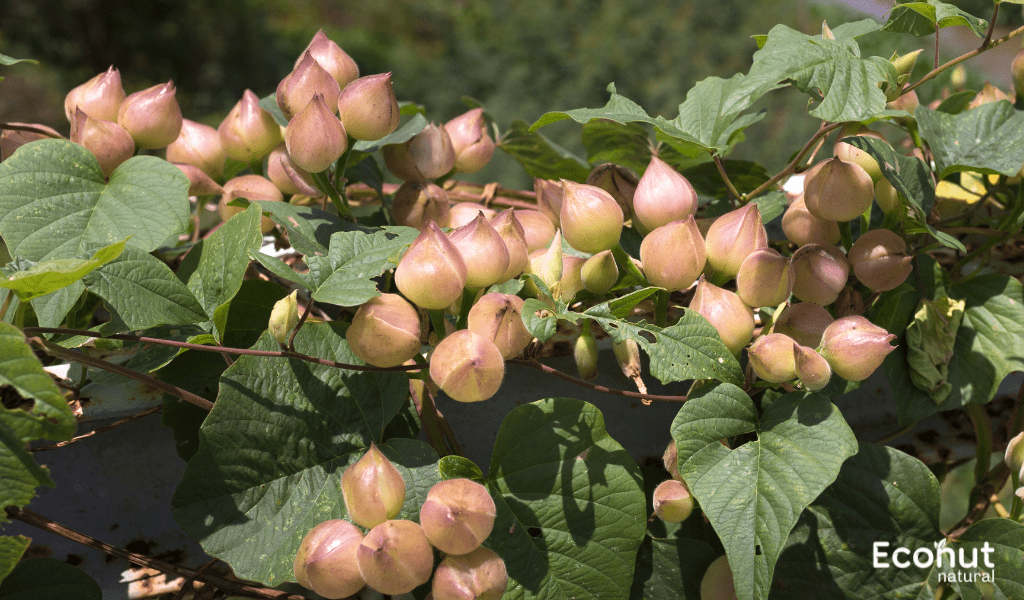Trivrit (Operculina turpethum) is a perennial climbing plant native to India. It belongs to the family Convolvulaceae. Trivrit has been used in traditional Ayurvedic medicine for centuries due to its various medicinal properties.
Discription
Trivrit, scientifically known as Operculina turpethum, is a perennial climbing plant belonging to the family Convolvulaceae. It is native to tropical regions of Asia, particularly found in India, Sri Lanka, and parts of Southeast Asia.
Physical Appearance:
Trivrit is a vigorous climber, often found twining around other vegetation or structures for support. It has thick, fleshy stems that can grow several meters in length. The leaves are heart-shaped or ovate, typically measuring 5-10 cm in length, with a smooth surface and pointed tip.
Flowers:
The plant produces small, trumpet-shaped flowers that are pale yellow or white in color. These flowers are borne in clusters along the stems and have a pleasant fragrance. They bloom during the warmer months, attracting pollinators like bees and butterflies.
Fruits:
After flowering, Trivrit produces small, spherical fruits that contain several seeds. These fruits are green when young, turning brown as they mature. Each fruit contains numerous seeds that are dispersed when the fruit capsule dries and splits open.
Medicinal Uses:
Trivrit has a long history of medicinal use in traditional Ayurvedic medicine. The roots of the plant are particularly valued for their therapeutic properties. They are used to prepare various herbal formulations and remedies for treating conditions such as constipation, indigestion, liver disorders, and skin diseases. Trivrit is believed to have laxative, purgative, and detoxifying properties.
Cultural Significance:
In addition to its medicinal uses, Trivrit holds cultural significance in many communities where it grows. It is sometimes used in religious rituals or ceremonies, and its medicinal properties are often referenced in ancient texts and scriptures.
Scientific Classification
| Kingdom | Plantae |
| Family | Convolvulaceae |
| Genus | Operculina |
| Division | Magnoliophyta |
| Class | Magnoliopsida |
| Order | Solanales |
| Species | O.turpethum |
Other Names
Latin Name: Operculina turpethum
Sanskrit Synonyms: Tribhandi, Triputa, Trivrit, Sarala, Suvaha, Rechani, Ardhachandra, Kumuda Gandhini
Tamil Name: Sivadai, Adimbu, Kumpncan, Paganrai
Malayalam Name: Chivaka
Kannada Name: Vilitigada, Aluthi gida, Bangada balli, Bilitigade, Devadanti, Nagadanti
English Name: India Jalap, Saint Thomas Lidpod, Transparent wood rose, Turpeth root
Hindi Name: Nisoth, Panila, Pithori
Telugu Name: Tegade
Bengali Name: Tevudi
Marathi Name: Nisottar, Nishottar
Gujarathi Name: Nasttara
Ayurvedic Properties
Hindi / Sanskrit
- Rasa, Tikta, Katu
- Guna, Laghu, Rooksha, Teekshna
- Virya, Ushna
- Vipaka, Katu
English
- Taste, Bitter, Pungent
- Physical Property, Light, dry, Piercing
- Potency, Hot
- Metabolic Property (After Digestion), Pungent
Benefits of Trivrit (Operculina turpethum)
Trivrit, scientifically known as Operculina turpethum, is a perennial climbing plant native to the Indian subcontinent. It has been used in traditional Ayurvedic medicine for centuries due to its various health benefits. Here, We discuss some of important benefits regarding Trivrit.
Betters Digestive System:
In addition to its laxative properties, Trivrit may also aid digestion. It can help alleviate digestive issues such as bloating, gas, and indigestion by promoting healthy bowel movements and supporting overall digestive function.
Detoxification:
Trivrit is believed to have detoxifying properties, helping to rid the body of toxins and waste products. By promoting regular bowel movements, it supports the body’s natural detoxification processes and may improve overall detoxification.
Helpful For Respiratory Health:
In traditional medicine, Trivrit has also been used to alleviate respiratory issues such as coughs and asthma. It is believed to have expectorant properties, helping to expel mucus from the respiratory tract and relieve congestion.
Useful In Antioxidant Activity:
This herb contains antioxidants that help protect cells from oxidative stress and damage caused by free radicals. Antioxidants are important for maintaining overall health and may help reduce the risk of chronic diseases such as heart disease and cancer.
Contain Laxative Elements:
This herb is primarily known for its potent laxative effects. It contains compounds that stimulate bowel movements, making it useful for relieving constipation. It acts by increasing intestinal motility and promoting the elimination of stool from the body.
Weight Management:
Due to its laxative effects and potential to improve digestion, Trivrit may aid in weight management efforts. By promoting regular bowel movements and supporting efficient digestion, it may help prevent constipation and bloating, contributing to a healthier weight.
Contain Anti-inflammatory Elements:
Some medical science suggests that Trivrit may possess anti-inflammatory properties, which could help reduce inflammation in the body. This potential benefit may make it useful for managing inflammatory conditions such as arthritis and inflammatory bowel diseases.
Also Read: Sharpunkha (Tephrosia Purpurea)
Side Effects of Trivrit (Operculina turpethum)
Trivrit, also known as Operculina turpethum or Indian jalap, is a plant commonly used in traditional Ayurvedic medicine. It’s primarily known for its purgative and laxative properties. While it can be beneficial for certain health conditions when used appropriately, it’s essential to be aware of side effects, especially when consumed in large doses or for extended periods. Here, We discuss Some side effects of Trivrit include.
Dehydration:
Prolonged or excessive use of Trivrit can lead to fluid loss due to its laxative effect, potentially resulting in dehydration if adequate fluid intake is not maintained.
Produces Allergic Reactions:
Some peoples may experience allergic reactions to Trivrit, resulting in symptoms such as skin rash, itching, or respiratory problems. Allergic reactions can vary in severity and require immediate medical attention if severe symptoms occur.
Interaction with Drugs:
Trivrit may interact with certain medications, particularly those affecting the gastrointestinal system or electrolyte balance. It’s essential to consult with a healthcare professional before using Trivrit, especially if you’re taking other medications concurrently.
Gastrointestinal Disturbances:
Since Trivrit is a potent laxative, it can cause gastrointestinal disturbances such as diarrhea, cramping, and abdominal pain, particularly if taken in excessive amounts.
Long Term Use Lead to Dependency:
Regular use of Trivrit as a laxative may lead to dependency, where the bowels become reliant on its stimulant effect to produce a bowel movement. This can result in difficulty having a bowel movement without the use of laxatives.
Avoid During Pregnancy and Breastfeeding:
Pregnant or breastfeeding women should avoid using Trivrit unless specifically recommended by a healthcare provider. Its effects on pregnancy and lactation have not been sufficiently studied, and there may be potential risks to the mother and baby.
Electrolyte Imbalance:
The purgative action of Trivrit can lead to the loss of electrolytes such as potassium, sodium, and magnesium, which are essential for various bodily functions. Electrolyte imbalances can cause symptoms such as weakness, dizziness, and irregular heart rhythms.
Conclusion
Trivrit, scientifically known as Operculina turpethum, epitomizes the enduring relevance of traditional medicinal plants. Across centuries, it has been a cornerstone of Ayurvedic medicine, celebrated for its diverse therapeutic properties. As contemporary research delves deeper into its mechanisms of action, Trivrit stands as a testament to the wisdom of traditional healing and the ongoing exploration of botanical remedies in the pursuit of health and well-being.
FAQS
What are the medicinal uses of Trivrit?
Trivrit has been traditionally used in Ayurvedic medicine for its purgative, laxative, and digestive properties. It is often prescribed to treat constipation, intestinal worms, indigestion, obesity, and other gastrointestinal disorders.
Is Trivrit safe to use?
While Trivrit can be beneficial for certain health conditions when used appropriately and in recommended doses, excessive consumption can lead to side effects such as diarrhea, dehydration, electrolyte imbalance, and abdominal pain. It is important to use Trivrit under the guidance of a qualified healthcare practitioner.
Can Trivrit be used for weight loss?
This herb is sometimes used as a natural remedy for weight loss due to its laxative properties. However, its use for this purpose should be approached with caution and under the supervision of a healthcare provider, as excessive use can lead to dehydration and electrolyte imbalances.

